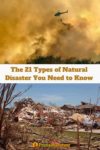Natural disasters are “unavoidable environmental events” that create significant life loss, injury, property damage, and dislocation.
There have always been natural disasters throughout human history, but natural disasters have been on the rise.
Natural disasters occur 3x more often today than in the 1970s and 1980s. In 2021, nearly 1 out of 10 homes in the USA were hit by natural disasters, and nearly 1/3 of homes in the USA are at risk of natural disasters. (1, 2, 3, 4)
Below are the main categories of natural disasters, a list, and information on how to prepare.
Also read: Natural disaster risk by state
What Are the 6 Main Categories of Natural Disasters?
Natural disasters can be divided into six categories:
- Geological
- Meteorological
- Hydrological
- Climate
- Biological
- Extraterrestrial.
There is a lot of crossover between these disaster types, though some might fit into multiple categories. For example, thunderstorms (meteorological disaster) can trigger landslides (geological disaster).
1. Geological Natural Disasters
Also called geophysical hazards, these disasters originate from inside the earth or involve solid earth moving. They often occur without warning, so there is no time to evacuate or take shelter.
Examples:
- Earthquakes
- Landslides
- Volcanoes
- Avalanche
2. Meteorological Natural Disasters
Short-term but extreme changes in weather conditions cause meteorological natural disasters. Luckily, there is usually advance warning and time to evacuate or take shelter before the disaster strikes.
Due to climate change, meteorological natural disasters are expected to increase in frequency and strength in many parts of the world.
Examples:
- Heatwaves
- Cold waves
- Hurricanes
- Tornadoes
3. Hydrological Natural Disasters
Hydrological natural disasters occur when water suddenly or violently moves or changes distribution. Because of climate change, hydrological natural disasters are on the rise. There often is no time to take shelter or evacuate before the hydrological disaster hits.
Examples:
- Flooding
- Tsunamis
- Rogue waves
4. Climate Natural Disasters
Climate natural disasters occur from lasting changes in atmospheric conditions. Because these disasters are long-term, they can cause mass displacements of people.
Understanding that these climate changes can also increase the frequency or intensity of other types of natural disasters, such as climate change contributing to hurricanes is essential.
Examples:
- Drought
- Wildfires
5. Biological Natural Disasters
Biological natural disasters involve exposure to living organisms or the toxic substances they produce. They can cause disease and death in humans or animals or massive crop destruction.
Examples:
- Epidemics
- Infestations
6. Extraterrestrial Natural Disasters
Extraterrestrial natural disasters originate from outer space and enter the Earth’s atmosphere.
While it may seem like something out of a movie, extraterrestrial natural disasters are an omnipresent risk and could be catastrophic. Unlike in the movies, there is usually little or no warning before the disaster occurs.
Examples:
- Asteroid and meteor impacts
- Solar flare
What Are the Most Common Natural Disasters in the USA?
Flooding is the most common natural disaster in the United States. While flooding is more common in some areas, it occurs in all parts of the USA. A flooding event has occurred on average every 2-3 days in the USA for the past 25 years. The frequency of floods is only increasing.
What Natural Disaster Causes the Most Damage in the US?
Until recently, flooding was the costliest natural disaster in the United States. This includes flooding as a result of hurricanes. Worldwide, flooding and drought are the most expensive natural disasters.
However, the coronavirus pandemic has changed that. It is estimated that the pandemic will cost more in 2020 alone than all of the world’s natural disasters combined in the past 20 years.
What Are the Deadliest Natural Disasters?
While flooding causes enormous economic damage, it is not the deadliest natural disaster. From 2000 to 2020, the deadliest natural disasters were earthquakes. Storms and extreme temperatures also caused high death tolls worldwide.
As of 2020, though, the coronavirus has become the deadliest natural disaster of modern times.
Also read: Man-made disaster types
List of Natural Disasters by Type
1. Earthquakes
The earth is made up of numerous tectonic plates which are constantly moving. Pressure builds up at plate boundaries. An earthquake occurs when this pressure is suddenly released as seismic energy. Earthquakes cause severe shaking and vibrating.
Earthquakes are responsible for most natural disaster deaths worldwide. Most of these deaths result from structural collapse: buildings falling on people.
Read: How to Prepare for an Earthquake
2. Landslides, Mudslides, and Rock Falls
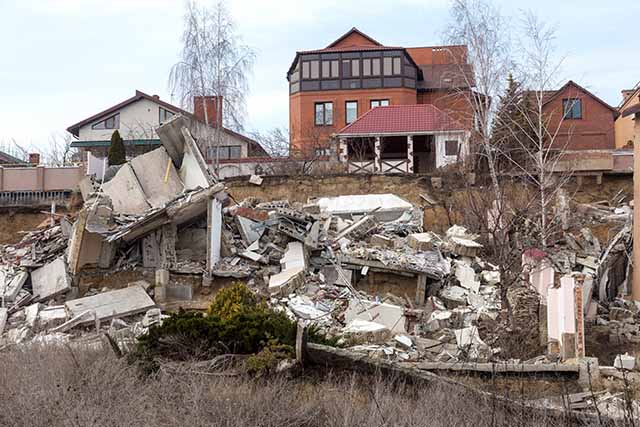
Landslides occur when the land on a slope collapses. The land begins to travel down the slope, picking up debris like rocks and mud. Mudslides are similar to landslides but mainly include water-saturated dirt which slides down the hill. Rockslides occur when solid rocks fall down a slope.
Rainstorms often trigger landslides and mudslides. Because of climate change, heavy rainstorms are becoming more common in some areas and thus increasing the risk of landslides and mudslides. Rock falls can also occur due to heavy storms. However, it is also typical for erosion or earthquakes to trigger rock falls.
3. Volcanoes
There are many active volcanoes worldwide, including 65 active volcanoes in the continental USA. The most famous of these is Mount Saint Helen’s in Washington State. It had a massive eruption in 1980, which killed 57 people. Since then, it has had three more minor eruptions.
Volcanoes can cause damage in numerous ways. Not only can they spew massive amounts of lava and rocks into the area, but they can trigger landslides or tsunamis.
The eruption can emit toxic gases like sulfur dioxide into the air. Ash from the volcano can cause respiratory problems and disrupt air travel. Because of this, a gas mask or respirator is an essential piece of gear for volcano preparedness. Read about gas masks and N95 masks.
4. Avalanches
Avalanches occur when a large mass of snow, ice, and debris falls down a slope. The avalanche can destroy whatever is in its path and bury people under the debris. Destruction of utility equipment can cause oil and gas leaks and widespread power and communication outages.
5. Extreme Temperatures
Extreme temperature disasters include heat waves, cold waves, and severe winters. Extreme temperatures can cause death directly, such as hypothermia and heatstroke. For example, nearly 200 people died in the 2021 Pacific Northwest heatwave.
The region usually does not get high temperatures, so many people don’t have air conditioning or fans.
Extreme temperatures can cause many other problems, too. Also, in 2021, the cold wave in Texas resulted in a massive power outage disaster because the grid wasn’t equipped to handle low temperatures. Dozens of people died during the cold wave due to hypothermia, road accidents, and carbon monoxide poisoning.
Read: How to Prepare for a Heat Wave
6. Blizzards
The National Weather Service defines a blizzard as a severe snowstorm that has:
- Sustained wind speeds or frequent gusts of 35 mph or more and
- Considerable falling or blowing snow that reduces visibility to less than ¼ of a mile.
Approximately 400 people die from blizzards each year in the USA. Many of these deaths are related to road accidents. Blizzard deaths also occur from falling tree limbs, heart attacks (such as when people shovel vast amounts of snow), or carbon monoxide poisoning from improper generator use during blizzard power outages.
Read:
7. Hurricanes
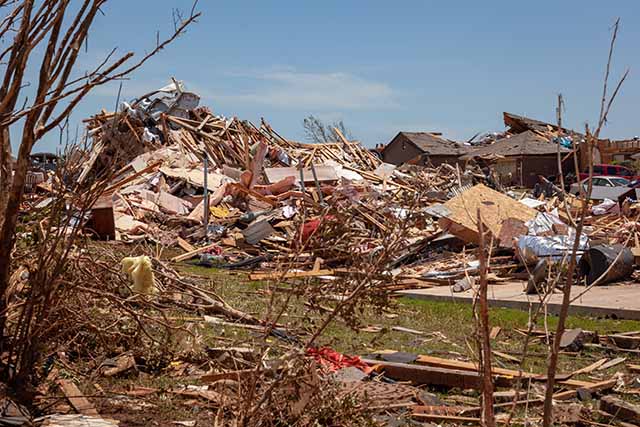
Hurricanes, also called typhoons and cyclones, are a type of tropical storm.
Hurricanes are divided into categories based on their wind speed. A category 5 hurricane has winds of at least 157 mph, strong enough to rip the roof off of buildings.
Hurricanes can also cause massive flooding and storm surges. Of all of the weather-related disasters to hit the USA in the past 30 years, hurricanes have caused the most damage.
Read:
8. Tornadoes
Tornadoes occur on every continent other than Antarctica but are most common in the United States.
The USA gets approximately 800 to 1,000 tornadoes annually, many of which are in “Tornado Alley.” The high winds of a tornado can rip apart homes and buildings. They lift debris like glass, causing it to turn into flying missiles that can injure or kill people.
Luckily, it is usually possible to get warning of tornadoes. This gives you time to secure objects, get pets from outside and take shelter.
Read:
9. Thunderstorms
While most thunderstorms are not severe, they can rise to the status of natural disasters. The heavy winds can cause damage to buildings. Sometimes, the thunderstorm turns into a derecho – a wind storm similar to a tornado but travels in a straight line. Lightning can cause fires, damage the electric grid and electrocute people.
Thunderstorms can also be particularly devastating to crops. Heavy rains and hail can destroy crops, which in turn causes the price of food to increase.
10. Sand and Dust Storms
Sandstorms and dust storms occur when strong winds pick up debris and blow it into the atmosphere. The difference between a sandstorm and a dust storm is the size of the particles: sandstorms have larger particles than dust storms.
These types of storms occur in the desert and flat, dry regions. For example, they are relatively common in Arizona and are the third leading cause of weather-related deaths in the state.
Because the storms reduce visibility, they can cause serious vehicle accidents – like the series of car crashes in 2021 in Utah that left 8 people dead.
11. Floods
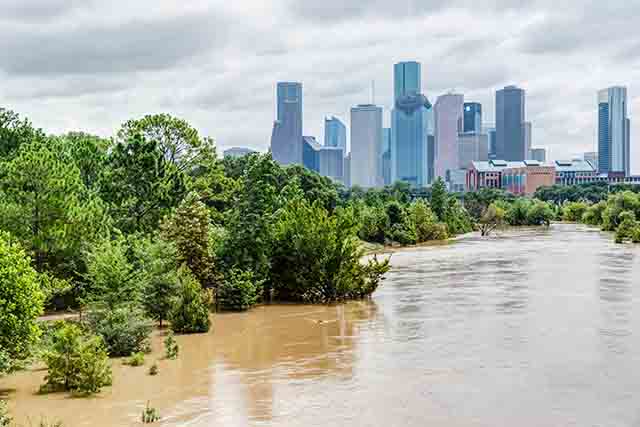
Flooding is one of the costliest and deadliest natural disasters in the USA and worldwide. They are also one of the most frequent natural disasters.
The rapidly moving water can sweep away people caught in floods. Vehicle accidents are also common during floods as it only takes six inches of water to make a car lose control, and a foot of water will float small vehicles.
Floodwater often mixes with sewage and other waste, which creates a sanitation nightmare and disease outbreaks. Mold grows easily in buildings saturated by floodwater, and the buildings may need to be gutted to clean the damage.
Also Read:
12. Tsunamis
A tsunami occurs when a massive amount of water is displaced, resulting in a massive wave that hits the shore.
Underwater earthquakes cause most tsunamis, but landslides, volcanic eruptions, and other geological events can also cause them. Because of this, tsunamis are often categorized as geological natural disasters and not hydrological disasters.
Tsunami waves can easily get to over 100 feet in height. The largest recorded tsunami was in 1958 in Lituya Bay, Alaska. Its wave was 1,700 feet high and destroyed five square miles of land.
13. Rogue Waves
Rogue waves are unusually large waves that can cause massive destruction. They are distinct from tsunamis because earthquakes or other geological causes don’t trigger them.
Instead, rogue waves seem to come out of nowhere. Rogue waves are particularly dangerous for boats and ships. However, they can also destroy coasts.
14. Drought
Droughts occur when an area gets below-average precipitation amounts for extended periods. The soil dries out, causing crops and livestock to die. This, in turn, can lead to other disasters like famine. This, in turn, can lead to mass migrations of populations, civil unrest, and war.
Because droughts change the soil, they can also lead to sandstorms and landslides.
Read: How to Capture Rainwater
15. Wildfires
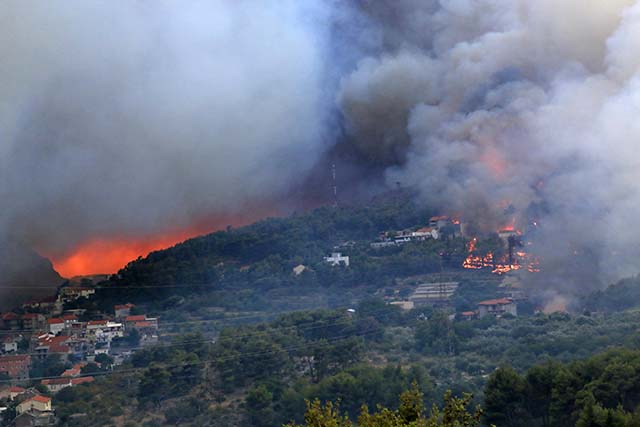
Wildfires are often caused by humans, such as people not putting out campfires properly or by lightning. However, wildfires are increasingly occurring because of climate change. Increased temperatures mean drier soil and forest debris, allowing wildfires to spark quickly and spread rapidly.
The past few years have drastically increased wildfire frequency and damage. It’s only likely to get worse. Climatologists predict that wildfires will increase by 14% by 2030 and 30% by 2050.
Read:
16. Epidemics
Epidemics are widespread infections in a community. By contrast, pandemics are widespread infections across multiple countries or continents. The COVID-19 virus is the best-known example of an epidemic that became a global pandemic.
However, epidemics don’t just occur from viruses. They can also occur from bacteria, parasites, fungi, or prions (infection agents). Epidemics such as Brazil’s 2015 Zika virus outbreak can also be vector-borne.
17. Infestations
Infestations like swarms of locusts might seem like something that only occurred during biblical times, but they are still genuine threats.
Climate change is causing pest life cycles and behavior changes, allowing them to survive and reproduce. The pests can consume entire crops, which can then cause famine and increased food prices.
Pest infestations can also lead to disease epidemics. This happened during the Bubonic Plague when fleas on rats spread the bacteria, which killed an estimated 25 million people. Malaria and Lyme disease are still spreading through pest infestations today.
18. Impact Events
Impact events are when asteroids, meteors, or other space objects hit the Earth. Numerous events have occurred throughout the earth’s history, but the most devastating occurred millions or even billions of years ago.
This doesn’t mean that an impact event couldn’t occur again. Because outer space is so vast, it is unlikely that we would even get much warning before an impact. For example, scientists only spotted the 10-foot wide asteroid that struck Iceland in March 2022, two hours before impact.
Space debris can cause destruction even if it doesn’t hit the Earth. For example, an exploding comet within the Earth’s atmosphere could trigger an airburst.
19. Space Weather
The energy unleashed from space storms can travel to Earth and cause damage. A solar flare is probably the most concerning of these space weather events.
A solar flare is essentially an explosion on the sun. The explosion causes clouds of electrons, ions, and atoms to surge into space, resulting in radiation and solar wind storms. It can trigger a geomagnetic storm, which could cause an electromagnetic pulse – EMP – to hit the Earth.
The EMP by itself isn’t necessarily dangerous to humans. However, an EMP could destroy electrical equipment. Some predict that a major EMP event would take out the grid and leave us in darkness for decades. Since nearly everything from water treatment to supply chains relies on electricity, civilization could collapse.
Read: Sensible Guide to EMP Preparedness
https://www.flooddefenders.org/problem
https://www.floodsafety.com/national/life/statistics
https://theconversation.com/covid-19-cost-more-in-2020-than-the-worlds-combined-natural-disasters-in-any-of-the-past-20-years-156646
https://www.capitaldaily.ca/news/covid19-disaster-ranking-mortality
https://www.prb.org/resources/which-types-of-disasters-are-the-deadliest-in-the-u-s-the-answer-is-surprising/
https://www.fbiic.gov/public/2010/mar/FloodingHistoryandCausesFS.PDF
https://www.fbiic.gov/public/2010/mar/FloodingHistoryandCausesFS.PDF
https://ourworldindata.org/natural-disasters
https://www.cdc.gov/disasters/landslides.html
https://disasterscharter.org/web/guest/disaster-types/-/article/landslides
https://www.coursehero.com/study-guides/wmopen-geology/outcome-types-of-mass-movement/
https://disasterscharter.org/web/guest/disaster-types/-/article/volcanoes
https://storymaps.arcgis.com/stories/d97e749d7f324b9face81753fc10fbc2
https://www.downtoearth.org.in/news/natural-disasters/crops-failing-against-rising-temperatures-pest-attacks-study-69317
https://reliefweb.int/report/sudan/sudan-desert-locust-might-constitute-natural-disaster
https://eos.org/articles/record-locust-swarms-hint-at-whats-to-come-with-climate-change
https://www.smithsonianmag.com/science-nature/could-the-sun-set-off-the-next-big-natural-disaster-78352782/
https://www.swpc.noaa.gov/phenomena/geomagnetic-storms
https://www.nationalgeographic.com/science/article/130214-biggest-asteroid-impacts-meteorites-space-2012da14
https://weather.com/science/environment/news/arizona-dust-weather-deaths
https://abcnews.go.com/US/dead-utah-sandstorm-series-car-crashes/story?id=79054429
https://www.rmets.org/metmatters/haboob-sandstorm-or-dust-storm
https://pubmed.ncbi.nlm.nih.gov/30488534/
https://www.sciencedirect.com/topics/earth-and-planetary-sciences/flood-damage
https://www.sciencedirect.com/topics/engineering/flood-damage
https://www.pbs.org/wgbh/nova/tsunami/once-nf.html
https://wiki.seg.org/wiki/Natural_disasters_and_hazards
https://www.nrdc.org/stories/drought-everything-you-need-know
https://www.ifrc.org/our-work/disasters-climate-and-crises/what-disaster/droughts
https://www.theguardian.com/environment/2022/feb/23/climate-crisis-driving-increase-in-wildfires-across-globe-says-report-aoe
https://www.c2es.org/content/wildfires-and-climate-change/
https://sgp.fas.org/crs/row/R46270.pdf
https://www.weather.gov/lmk/tornadoesfaq
https://www.npr.org/2022/01/03/1069974416/texas-winter-storm-final-death-toll
https://planningforhazards.com/avalanche
https://www.theguardian.com/us-news/2021/jul/08/pacific-northwest-heatwave-deaths
https://en.wikipedia.org/wiki/2021_Texas_power_crisis#Immediate_weather_and_power_plant_failures
https://www.geni.com/projects/People-Who-Died-Directly-or-Indirectly-from-a-Blizzard-or-Snowstorm/40035#:~:text=In%20the%20United%20States%2C%20about,5%20years%20caused%20by%20blizzards
https://w1.weather.gov/glossary/index.php?word=blizzard
https://www.nhc.noaa.gov/aboutsshws.php
https://www.weather.gov/lmk/derecho
https://www.prep4agthreats.org/Natural-Disasters/thunderstorms
https://farmpolicynews.illinois.edu/2020/08/derecho-damage-begins-to-unfold-estimated-37-7-million-acres-of-farmland-impacted/
